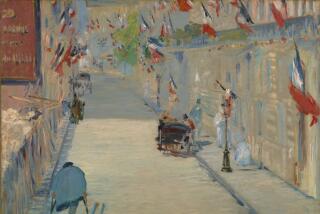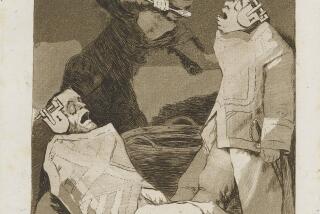Thousands of Art Lovers Follow the Legend of Van Gogh in Arles
ARLES, France — We must go on hoping that in some other life we’ll see a better thing than this. --Vincent van Gogh
“Nature here is so extraordinarily beautiful. . .everywhere the sky is a marvelous blue, and the sun sheds a radiance of pale sulphur that is soft and lovely. What a country!”--Vincent Van Gogh
No one who retraces the final years of Vincent van Gogh can help but be moved by the tragedy of the tortured artist’s life.
Although surrounded by the peacefulness of Provence, Van Gogh’s companions were mostly agony, suffering and disappointment. One asks why a man who brought to the world such beauty was rewarded with tragedy.
Still, in Arles Van Gogh did enjoy fleeting moments of contentment, rare as they were, and it is to Arles that disciples of Van Gogh continue their pilgrimages. His presence in 1888-89, a period when he produced some of his finest works, has inspired an industry that produces the very wealth that eluded the famous Dutch artist in his lifetime, for Arles thrives on tourism.
This isn’t to say that everyone who travels to Arles is drawn by the Van Gogh legend. Others travel south purely for the pleasure of Provence and the treasures that remain of the Roman and other eras: the wall that surrounds Arles, the immense Roman arena (still the scene of bullfights and plays), Eglise Saint-Trophime and the Baths of Constantine.
Still, it is the Van Gogh saga that lures thousands to Arles, the Provencal village about which Van Gogh wrote endless letters to his brother Theo, an art dealer in Paris.
Nature here is so extraordinarily beautiful ... everywhere the sky is a marvelous blue, and the sun sheds a radiance of pale sulphur that is soft and lovely. What a country!
Indeed, Arles is a joy, particularly the old town with its narrow, winding streets, its ancient buildings and lovely squares. Van Gogh painted Cafe du Soir in Place du Forum where he spent evenings seeking a kind word.
In my picture of the Night Cafe I have tried to express the idea that the cafe is a place where one can ruin one’s self ....
The cafe was the scene of his own slow mental and physical deterioration, a place where he spent the few francs he could muster on absinthe. Although Van Gogh brought fame to Cafe du Noir, today it is gone, replaced by an ordinary store that is devoid of the slightest notion that the celebrated Dutch master ever existed. The faithful gather instead in Restaurant Vaccares, above the store, to reminisce about Van Gogh while pouring expensive wines and enjoying the bounty of Provence.
Others in the square below share little tables beneath a canopy of plane trees that spread their shade in the heat of the day, and facing the square is an ancient hotel on whose porch the proprietress, an old Frenchwoman with stringy gray hair, speaks not only of Van Gogh but of the Americans who liberated her village during World War II. It is evident that her gratitude still prevails; in her lap she displays the American flag she says she herself made 40 years ago. Clutching an artificial rose, Mme. Germaine Gilbert waves the flag at a group of Americans.
Elsewhere in Arles, others occupy tables beneath leafy trees at Place Voltaire while waiters deliver beer and carafes of wine from the Bistro Le Pitchounet and Mu Bar de la Paix. A sense of age exists here. Buildings with shuttered windows surround the square and guests enter the door of Hotel Gauguin. Yes, Gauguin, not Van Gogh. For even in death Van Gogh seems spurned.
Rejected by an early love and frustrated in other affairs, Van Gogh turned to a prostitute in Arles for the affection he longed so desperately for.
Like everyone else, I feel the need of relations and friendship, of affection.
It had been a gloomy Paris winter that drove the artist south, his tortured soul longing for the purity of Provence.
One evening I saw a red sunset, its rays falling on the trunks of pines growing among a tumble of rocks. It was superb.
The curious who retrace the artist’s footsteps discover warmth at Hotel d’Arlatan on Rue du Sauvage, a 15th-Century mansion with ivy-covered walls that tower over a courtyard and a fountain that provides a melody, both day and night.
Only moments off Place du Forum, Hotel d’Arlatan is a showplace with quiet rooms, splendid antiques and the enthusiasm of proprietors Roger and Colette Desjardin.
One enthusiastic guest left behind this note: “One of the loveliest hotels I have ever visited.”
Hotel d’Arlatan features a wall from the Palace of Constantine. Shiny tile floors lead to 46 rooms, each decorated differently, each a small and fascinating museum with 15-foot ceilings. No. 6 with its balcony is known as the Juliet Suite, and France’s Mitterand is said to have occupied No. 7, next door.
Because this is the heart of Arles’ protected area, Hotel d’Arlatan is a monument and as such can’t be tampered with. The courtyard with its single palm tree recalls scenes of Tangier and Marrakech, and rose-covered walls attract artists who are seduced by the same vivid colors that lured Vincent van Gogh.
Other visitors seek shelter at Hotel Jules Cesar, a 17th-Century Carmelite convent facing Boulevard Lices with its boutiques and sidewalk cafes and whose Restaurant Lou Marques is ranked among the city’s finest.
Such pleasures eluded Van Gogh during a life of poor health and poverty. Only toward the end did he enjoy a few, short-lived moments of peace in his celebrated Yellow House, which he shared briefly with Gauguin and where his frail health worsened. For the most part, only the clear skies and sunshine of Provence brightened otherwise lonely days for Van Gogh.
All this warmth makes poverty less harsh and melancholy.
For Van Gogh, melancholy was a lifetime companion, and he sacrificed himself for his art. Sheldon Cheney wrote: “No artist ever gave himself more self-destructively, more fanatically, more lovingly to painting.”
Of the more than 800 paintings and 700 drawings Van Gogh created in his lifetime, many of his finest reflected the life and beauty of Provence. The collection includes orchards, scenes of the Rhone, a portrait of the postman Roulin, Van Gogh’s beloved sunflowers and the little drawbridge that reminded him of his native Holland.
Unfortunately along with the good sun, there is the devil mistral.
The mistral blows this day, a fierce wind that shrieks through the narrow streets of Arles. Its mournful wail drove Van Gogh mad, that and the absinthe and the hoplessness he suffered as he worked inexhaustively, turning out sometimes two masterpieces in a single day.
Van Gogh had envisioned the Yellow House as a commune of sorts for other artists with whom he corresponded in Paris. He gathered a table and chairs and beds for the arrival of Gauguin. It worked well in the beginning, but then the painters quarreled and they drank great amounts of absinthe. Van Gogh stalked Gauguin with a razor; Gauguin thwarted the attack and Van Gogh returned to the Yellow House where, in his madness, he slashed off part of his right ear, placed it in a towel and delivered it to the prostitute Rachel who’d jested about the artist’s ears during an earlier visit.
After the incident, Gauguin returned to Paris and Van Gogh was hospitalized. Today as the mistral howls, shutters bang against the old hospital and litter is swept by the wind to the door of the forbidding old building. What irony that the former hospital serves on occasion as an exhibit hall for paintings and drawings, among them Van Gogh’s.
I feel weak and rather uneasy and frightened.
After Van Gogh returned to the Yellow House, he was taunted by village youngsters who urged him to cut off his other ear. Exhausted, Van Gogh committed himself to an asylum at St. Remey where his moods alternated between calm and despair.
Today was a real day of spring; the fields of young corn with the violet hills in the dist an ce are so beautiful, and the almond trees are beginning to bloom everywhere.
In the asylum Van Gogh continued to paint. Still the melancholy continued and after 12 months, homesick to see his brother Theo in Paris, he left the hospital in May, 1890.
After several days in Paris, Van Gogh traveled to the little village of Auvers-sur-Oise and the care of Dr. Paul-Ferdinand Gachet, a friend of Paul Cezanne. And although he painted enthusiastically at first, inspired by the cornfields, the river, the valley and the local church, Van Gogh’s letters to Theo carried new messages of despondency.
I am far from having reached any kind of tranquility. The prospect grows darker; illness and death have no terror for me.
In final desperation, Van Gogh shot himself with a borrowed revolver, dying two days later in the arms of Theo in the small, gloomy garret above a restaurant in Auvers-sur-Oise where today, nearly a century later, his room is kept intact.
Vincent van Gogh is buried beside his brother Theo in a cemetery not far away. Ivy from Dr. Gachet’s garden covers both graves and a note from Theo’s widow reads: “Ivy as a symbol of constant affection links Vincent and Theo’s graves, two brothers who loved each other tenderly.”
A plain marker, the name nearly indelible due to time and weather, reads simply: Vincent van Gogh, 1853-1890. The artist was barely in his 37th year when finally he succumbed to the terror that life had held for him.
Less than a mile from the cemetery stands the church Van Gogh painted, L’Eglise de Auvers, and the song of blackbirds is heard in the Forest de l’Isle.
In Arles little remains to recall Van Gogh’s troubled sojurn, this brief period when the artist produced so many masterpieces. Gone is the Yellow House as well as Cafe de la Gare, both destroyed in the 1944 bombings, and so Place Lamartine is nothing more than an empty lot beside the Rhone.
Gone too is the original Pont de l’Anglois, the little drawbridge Van Gogh painted with such ardor--it too a casualty of the war. Later M. Desjardin of Hotel d’Arlatan and others gathered donations for a replica over a little river several kilometers outside Arles. Also gone is the brothel where Van Gogh discovered moments of tenderness with the prostitute Rachel.
No monument marks his time in Arles. There is but a small bust in the lovely Jardin d’Ete where Van Gogh set the scene to canvas and where on this very day a lovely girl suns herself on a park bench while others share the shade of a chestnut tree.
There remains another line from Vincent van Gogh to his brother Theo: If one really loves nature, one can find beauty everywhere.
That beauty is still here, throughout Arles.
More to Read
Sign up for The Wild
We’ll help you find the best places to hike, bike and run, as well as the perfect silent spots for meditation and yoga.
You may occasionally receive promotional content from the Los Angeles Times.






